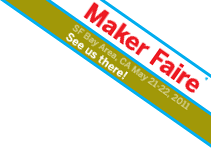History of the RULAV
This story begins in Summer 2007. Eliot is five. His family's back yard is mostly dominated by a rotting deck, and the few square feet left over for lawn are colonized by a knot of weeds. Christina decides it's time to landscape the back yard, “for the children.” Christina shows Jon a sheet of paper with her plan for the yard: a modest set of stairs here, mostly lawn, a flower strip along the fence, and here under the trees: a treehouse for Eliot!“Have you told Eliot about this already?” Jon asks, cautiously.
“Oh, yeah! He's really excited about it!” says Christina.
“Greeeeat,” say Jon, realizing he's been committed. Then inspiration strikes. Unfunded mandate? Fine. “Okay, I'll build a treehouse, but I'm not going to spend a month just to make an ordinary pressure-treated-lumber-and-tar-paper monstrosity.
Nope, we're going to Boeing Surplus.”
Before it closed at the end of 2007, Boeing Surplus was a staple in the Seattle maker world. There was a lot of junk there, but many reports of great finds by the patient scrounger. Jon lived too far away to go often enough to get the really good stuff. But he and Eliot scored four big sheets of weatherbeaten sheet aluminum and three 24-foot thick-walled aluminum tubes. We strapped our loot precariously to the roof of the Ford Escort, and drove home on a non-freeway route, to prevent the airplane parts from become airborne before they were made into an aircraft.
Jeremy's involvement came later. Not being a good metalworker, the project sounded interesting, but not something he could participate in. At first, it sounded like a static display -- other than the shape and the material, pretty much the same as any other treehouse. But then Jon started talking about features that would make it come alive: pilot-controlled thrusters! A paint-shaker that simulates the rumble of takeoff! Jeremy got excited and proposed that it was missing the key artifact that screams "1950's-era fictional space program": lots of flashing lights and dials and buttons and beeps.
One of Jeremy's todo-list items -- for about 10 years, at that point -- was to learn electronics. This seemed like a good excuse. The plans started out simple: build a big array of randomly flashing LEDs. As is obvious from the rest of this web site, the scope soon got wildly out of control. Before we knew it, we were building a distributed system on a custom operating system and getting custom printed circuit boards fabricated by the dozen in China.

